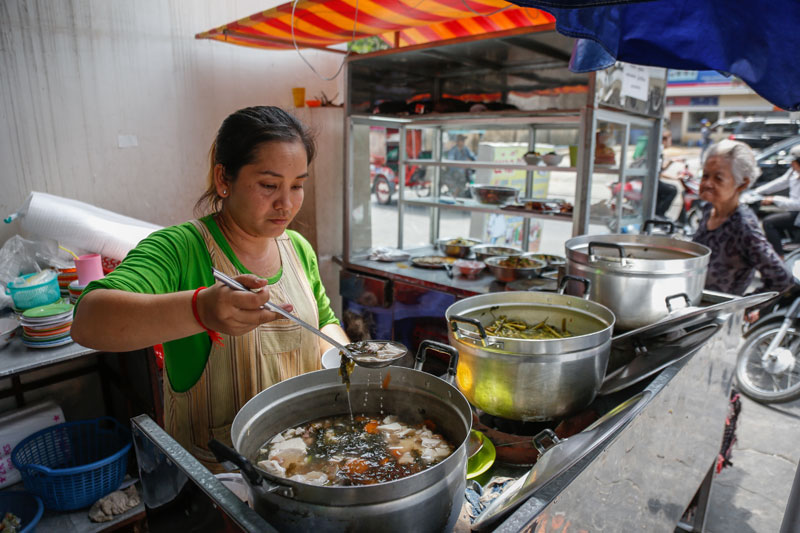Every day between 12 and 2 p.m., activity in Phnom Penh nearly grinds to a halt. Offices empty out and phones are left unanswered. It’s lunchtime.
While some city residents will head home or to fancy restaurants to seek out their midday meal, many more will make their way to the nearest “hang bai,” a street-side, family-run restaurant selling various soups, stews and braised dishes.

According to a study being published in the May issue of the “Austrian Journal of South-East Asian Studies,” these hang bai, or “soup-pot restaurants,” have become literal melting pots of Khmer cuisine, where regional and urban culinary influences blend together into something unique.
“Soup-pots are the most accessible and transparent form of eating Khmer cuisine in Phnom Penh,” said the study’s author, Hart Feuer, in a recent interview.
There is no menu at a soup-pot restaurant; rather, the proprietor chooses a selection of dishes to cook every day and displays them to customers, who pick the ones they want to eat with a plate of rice.
“It is like a mom deciding what to cook for her kids,” said Mr. Feuer, a senior research fellow at the Center for Khmer Studies.
“The reason that these soup-pot restaurants try to keep the range of Khmer cuisine is because they work like housewives. They worry about boring their customers with the same food, while trying to meet demands from customers for seasonal foods,” he added.
For his study, entitled “Urban Brokers of Rural Cuisine: Food Literacy at Cambodian Soup-Pot Restaurants,” Mr. Feuer surveyed 120 Phnom Penh residents. He found that when Cambodians eat out, they go to soup-pot restaurants more than 56 percent of the time—4.1 times per week, on average. This held true across all social classes, he said.
“Anyone can go in there and have the same meal” despite their socio-economic status, he said.
Crucially, because of their emphasis on fresh produce and seasonality, these restaurants also serve as a link between the city and provincial life; they allow “urbanites to experience a sense of nostalgic rurality despite the modern comforts and hygiene, while allowing rural migrants a familiar dietary experience despite being in the city,” Mr. Feuer writes in his paper.
They also teach younger Cambodians—who might be more inclined to snack on a Burger King Whopper than a bowl of num banhchok, Khmer-style noodles—about the country’s food culture, at times even resurrecting long-forgotten recipes.
“It’s a learning space for kids; they learn how to eat spicy things, dishes their moms never made, and adults remember dishes they had forgotten existed,” Mr. Feuer said.
This is certainly true of the nameless soup-pot restaurant run by Nil Bora, 57, on a side street in Daun Penh district. Without ever opening a cookbook, she has cooked between 13 and 15 dishes every day for the past six years, often relying on memories of her mother’s culinary prowess.
“A long, long time ago, when I was young, my mother worked as a cook in the Royal Palace. When I was 12 years old she stopped, but before, I used to look at how she cooked. She prepared Khmer foods like prahok [fermented fish paste] machou yuon [Vietnamese sour soup] and machou kroeung [mixed vegetable soup],” Ms. Bora said.
Calling upon these memories, one of her most popular dishes is this same rendition of samlor machou kroeung, a sour soup made up of morning glory, eggplant, prahok, lemon grass, tamarind, soy sauce, shallots, krasang seeds, and beef, chicken or fish.
Still, when planning what to cook, Ms. Bora said she takes younger Cambodians’ palates into consideration. “I need to be creative,” she said.
“The food from one generation to another has changed a little…. Now some food is [imported] from overseas. So I have to customize my mother’s recipes to create something new that attracts customers.”




